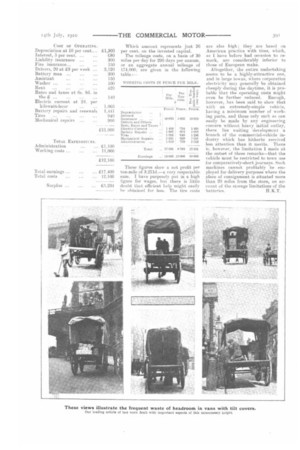From Our U.S.A. Correspondent.
Page 6

Page 7

If you've noticed an error in this article please click here to report it so we can fix it.
The American electric delivery wagon is a striking example of the adaptation of an existing type of vehicle to something for which it never was intended. It has been successful, because it has been used only for purposes for which such a vehicle can be profitably employed—the delivery of merchandise within the limits of a city's boundaries, for which service neither speed nor staying power are needed, and it is with these limitations, therefore, that the following remarks are to be taken.
I do not propose to give a detailed description of these vehicles—their appearance is well known, even on your side of the Atlantic. The Lansden electric truck, 375 of which are owned by the Adams Express Co., is typical of the type ; they are built by the Lansden Co., of Newark, N.J., and resemble ordinary railway delivery vans without horses. Such a vehicle is driven by two motors, which transmit their power through unenclosed spur gearing to two jack shafts, and these, in turn, through side chains to the driving wheels. The battery is slung underneath, and is readily removable for recharging.
The general use of these vehicles is for the collection or delivery of luggage and parcels between private houses and railway stations; they are widely employed in every city in the United States, and it is extremely doubtful whether any other type of vehicle would prove so useful or could be so cheaply operated.
In the States the average price of electric current for power 'imposes is about 4 cents, per kilowatt-hourin English currency 2d.—and this low price has been a potent factor in popularizing the electric vehicle. In addition to the very large concerns, of which the Adams Express Co. is one example, there are innumerable smaller companies who are operating fleets of similar vans, and the following figures of operating costs are typical of others. I am indebted to the " Power Wagon " for some of the figures given.
The figures are those for a fleet of 20 two-ton vans operating in a thicklypopulated city ; such items as rent, therefore, are on a heavy scale. Owing to the absence of what may be termed mechanical parts it is found that the two men who look after the charging of the batteries are easily able to undertake all running repairs. Naturally the heaviest item in these costs is that of battery repairs and it is found that the life of a battery, that is to say, of the plates, rubber separators, jars and wood crates is two years. In the repair costs, tires rank second and mechanical details third. Painting costs about £25 per car, per year, and this figure is sufficient to keep it in first-class condition. The number of reserve batteries is, of course, a charge which must be regulated by the mileage the wagons travel ; for long dis tance journeys a greater number than is allowed for in the following figures might be necessary, but, as a general rule. for city work, 50 per cent. of the whole number in use on the vehicles is amnle. The mileage, it will be observed, is low ; if this were increased (and the vehicles are easily capable of it) the cost of operation might be somewhat reduced. For special cases modification in the tables is of course necessary. The item of rent is based upon ls. per sq. ft. of garage per annum and include-s light, heat, and water.
CAPITAL INVESTMENT.
20 Wagons complete with bat teries at 2680 ... ... £13,600 10 Reserve batteries ... ... 1,150 Switchboard and station equipment ... 1,000 Working capital ... 4,250 Which amount represents just. 26 per cent, on the invested capital.
The mileage costs, on a basis of 30 miles per day for 290 days per annum, or an aggregate annual mileage of 174.000, are given in the following table :— These figures show a net profit per ton-mile of 3.211d.—a very respectable sum. I have purposely put in a high figure for wages, but there is little doubt that efficient help might easily he obtained for less. The tire costs
are also high ; they are based on American practice with tires, which, as 1 have before had occasion to remark, are considerably inferior to those of European make.
Altogether, the entire undertaking seems to be a highly-attractive one, and in large towns, where corporation electricity may generally be obtained cheaply during the daytime, it is probable that the operating costs might even be further reduced. Enough, however, has been said to show that with an extremely-simple vehicle, having a minimum number of working parts, and those only such as can easily be made by any engineering concern without heavy initial outlay, there lies waiting development, a branch of the commercial-vehicle industry which has hitherto received less attention than it merits. There is, however, the limitation 1 made at the outset of these remarks—that the vehicle must. be restricted to town use for comparatively-short journeys. S itch machines cannot profitably be employed for delivery purposes where the place of consignment is situated more than 20 miles from the store, on account of the storage limitations of the batteries,




















